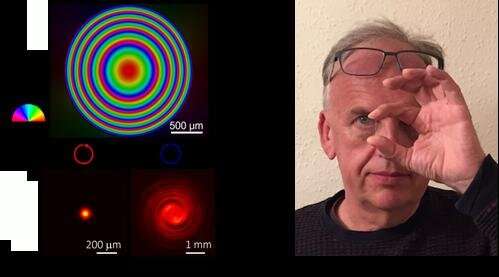Laser writing enables practical flat optics and data storage in glass

Femtosecond laser machining has emerged as an attractive technology enabling applications ranging from eye surgery to direct writing on the bulk of transparent materials. Scientists from the University of Southampton, UK, demonstrated a new regime of ultrafast laser writing in silica glass, which produces anisotropic nanostructures and related birefrigence with negligible transmission loss. The technology enables practical wavefront shaping with flat optics and polarization beam shaping of high power lasers from ultraviolet to infrared, as well as high-capacity optical data storage.
Conventional optics (e.g. lenses or mirrors) manipulate the phase via optical path difference by controlling thickness or refractive index of material. Recently, researchers reported that arbitrary wavefronts of light can be achieved with flat optics by spatially varying anisotropy, using geometric or Pancharatnam-Berry phase. However, despite various methods employed for anisotropy patterning, producing spatially varying birefringence with low loss, high damage threshold and durability remains a challenge.
In addition, the technologies of birefringence patterning have been also used for generating light beams with spatially variant polarization known as vector beams, in particular with radial or azimuthal polarization. Radially polarized vector beams are especially interesting due to the non-vanishing longitudinal electric field component when tightly focused, allowing superresolution imaging. Radial polarization is also the optimal choice for material processing. On the other hand, azimuthal vector beams can induce longitudinal magnetic fields with potential applications in spectroscopy and microscopy. Nonetheless, generating such beams with high efficiency is not a trivial matter.
In an article published in Light Science & Applications, scientists from the Optoelectronics Research Centre, University of Southampton, UK, demonstrated a new type of birefringent modification with ultra-low loss by ultrafast laser direct writing in silica glass. The discovered birefringent modification which is completely different from the conventional one originating from nanogratings or nanoplatelets, contains randomly distributed nanopores with elongated anisotropic shapes, aligned perpendicular to the writing polarization, which are responsible for the high transparency and controllable birefringence.
This birefringent modification enabled fabrication of ultra-low loss spatially variant birefringent optical elements including geometrical phase flat prism and lens, vector beam converters and zero-order retarders, which can be used for high power lasers. The high transmittance from UV to near-infrared and high durability of the demonstrated birefringent optical elements in silica glass overcome the limitations of geometrical phase and polarization shaping using conventional materials and fabrication methods including photo-aligned liquid crystals and meta-surfaces.
The researchers report: "We observed ultrafast laser induced modification in silica glass with the evidence of anisotropic nanopore formation representing a new type of nanoporous material. The technology of low loss polarization and geometrical phase patterning widens the applications of geometrical phase optical elements and vector beam convertors for high power lasers and visible and UV light sources. The space-selective birefringent modification with high transparency also enables high capacity multiplexed data storage in silica glass."
More information: Masaaki Sakakura et al, Ultralow-loss geometric phase and polarization shaping by ultrafast laser writing in silica glass, Light: Science & Applications (2020). DOI: 10.1038/s41377-020-0250-y
Journal information: Light: Science & Applications
Provided by Chinese Academy of Sciences





















